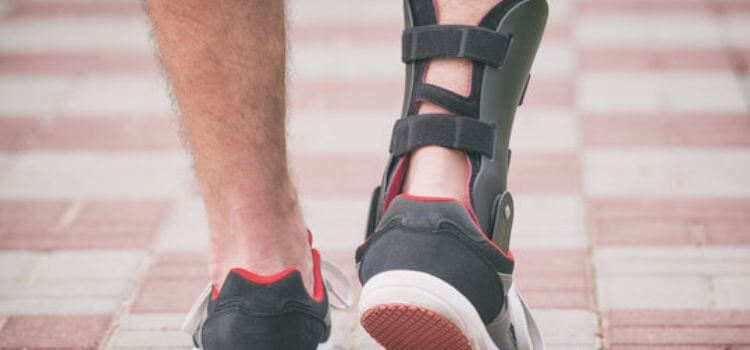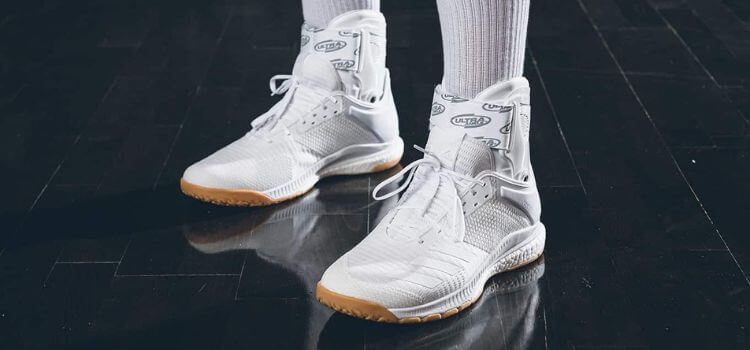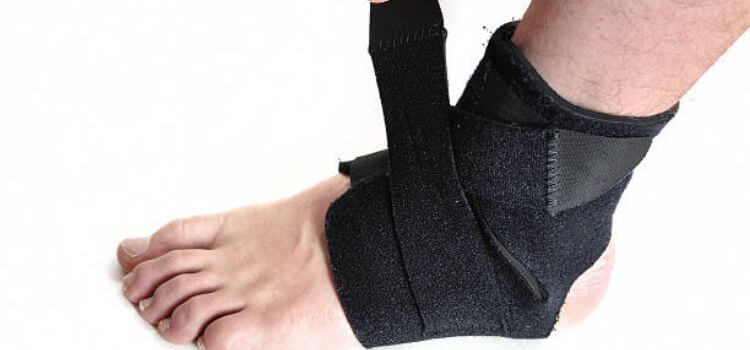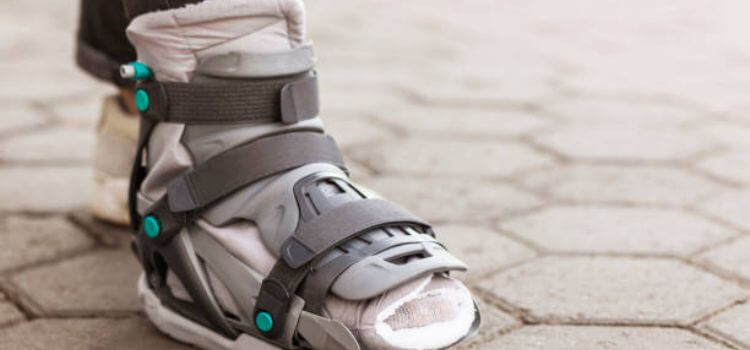To wear an ankle brace with shoes, first ensure your brace fits snugly over a sock before putting on a spacious, supportive shoe. Next, lace your shoe up over the brace for stable, comfortable wear.
Wearing an ankle brace can provide the necessary support and protection during physical activities if your ankle is injured or weak. Getting it right ensures both comfort and efficacy, whether you’re an athlete looking to perform your best or recovering from an ankle injury.

The key is to select the right type of brace and shoe combination to accommodate the brace while still giving your foot the support it needs. A brace can help stabilize your joint, minimize the risk of re-injury, and provide compression to manage inflammation. Choosing shoes with a wider toe box, adjustable straps, or laces allows the necessary room to fit an ankle brace without constricting movement or causing discomfort.
Introduction To Ankle Braces
An ankle brace is a supportive garment. It fits around the ankle.
It protects, supports, and prevents injuries. Athletes and people with ankle problems often use it. Let’s explore the value it provides.
The Role Of Ankle Braces In Injury Prevention
Ankle braces hold the joint in place, reducing excessive movement. Good braces also minimize the risk of sprains and strains and protect against further damage during healing.
- Stabilizes the joint during movement.
- Limits ankle rollover and twisting.
- Increases awareness of ankle position.
Selecting The Right Ankle Brace For Your Needs
Choosing an ankle brace requires attention to fit, support level, and activity type.
| Brace Type | Use Case | Support Level |
| Compression Sleeves | Mild support for daily activities | Low |
| Lace-Up Braces | Sports requiring agility | Moderate to High |
| Hinged Braces | Post-injury Support | High |
Measure your ankle size for a snug fit. Consider braces with adjustable straps for better support. Think about breathability and comfort for long-term use.
Types Of Ankle Braces
Protecting your ankle is key when you’re on the move. Different ankle braces offer different levels of support, so it’s crucial to choose the right one for your needs. These braces fit into most shoes easily. Let’s explore the main types.
Compression Braces For Mild Support
Compression ankle braces are perfect for minor injuries. They provide gentle pressure. This helps reduce swelling and improve blood circulation. Made from stretchy materials, they slip into shoes without fuss.
- Lightweight fabric.
- Easy to wear.
- Provides mild compression.
Lace-up Braces For Adjustable Fit
Seeking a snug fit? Lace-up ankle braces are ideal. They give you control over the tightness, and you can adjust the laces for a custom fit. This type of brace ensures your ankle stays in place.
- Customizable fit.
- Sturdy support.
- Secures ankle firmly.
Hinged Braces For Maximum Protection
For severe injuries, hinged braces offer top-notch stability. They have metal or plastic supports on the sides, which allow for natural movement while preventing harmful twisting.

- Robust side supports.
- Allows for natural ankle motion.
- Prevents excessive rotation.
Preparing Your Ankle And Brace
Getting ready to slip on an ankle brace with shoes begins with two key steps: ensuring your ankle is clean and properly adjusting the brace for comfort and support. By following these guidelines, wearing an ankle brace won’t feel like a chore. Instead, it becomes a seamless addition to your daily routine. Let’s dive into the essential preparations.
Proper Ankle Hygiene Before Wearing A Brace
Clean skin is critical before strapping on an ankle brace. This prevents irritation, reduces odor, and maintains overall skin health. Make sure to wash your ankle gently with soap and water and dry thoroughly. Clean skin prevents brace slippage and ensures the material doesn’t rub against dirt or sweat.
- Wash your ankle with a gentle soap.
- Rinse well to remove all soap traces.
- Dry completely, focusing on areas the brace will cover.
- Apply a moisture-wicking fabric if your skin is sensitive.
Initial Fitting And Adjustment Of The Ankle Brace
Finding the right fit is fundamental for ankle brace effectiveness. A good fit secures your ankle, allowing for safe movement within your shoes. Start with the brace fully open. Slide your foot in, resting it flat on the floor. Strap up the brace, adjusting as needed for a snug fit.
- Open the brace completely to make room for your foot.
- Slide your foot in, keeping your heel grounded.
- Secure straps or lace up without tightening too much.
- Walk around to ensure there’s no discomfort or slipping.
- Readjust as needed for a perfect fit.
Selecting The Right Footwear
Wearing an ankle brace means making smart choices about your footwear. The right shoes can make a big difference. They can help your ankle heal and keep you comfortable. Let’s explore what features to look for in ideal shoes and which shoe types to steer clear of when sporting an ankle brace.
Features Of Ideal Shoes For Ankle Braces
Some shoe features can make wearing an ankle brace a breeze. Look for these:
- Wide Toe Box: Gives your toes space.
- Adjustable Fastenings: Velcro or laces work best.
- Low Heels: Keeps you stable and comfy.
- Removable Insoles: This makes more room for your brace.
- Supportive Sole: Cushions and supports your foot.

Opt for shoes that fit these features. Your feet and ankles will thank you. Aim for a combination of support and comfort.
Shoe Types To Avoid When Wearing An Ankle Brace
Some shoes need to match better with ankle braces. Avoid these types:
- High Heels: They can cause more harm.
- Narrow Shoes: They can squeeze your feet.
- Flip Flops: They need more support.
- Slip-Ons: Often too tight for braces.
Avoid shoes that may pinch or strain your ankle. Safety comes first, and comfort follows close behind. Pick shoes that let your ankle brace do its job.
Wearing The Ankle Brace With Shoes
An ankle brace can offer essential support and stability after an injury. But how do you wear it with shoes? This guide helps you combine comfort with healing, making sure your road to recovery walks hand in hand with your daily routine. Whether for sports or everyday wear, fitting an ankle brace into a shoe is a game-changer for protection and peace of mind.
Step-by-step Guide To Inserting The Brace
- Choose the right shoe: Pick one with enough room for the brace.
- Open all fasteners: Loosen straps or laces on the brace for easy inserting.
- Slide your foot in gently, placing the foot with the brace into the shoe.
- Adjust for fit: Ensure the brace sits comfortably within the shoe.
- Secure the brace: Tighten the straps or laces on the brace for snug support.
- Lace-up: Tie your shoe laces as you normally would for a secure fit.
Ensuring Comfort While Wearing The Combination
- Check the size: Your shoe may need to be a half-size larger to accommodate the brace.
- Wear proper socks: Cotton or moisture-wicking socks prevent blisters.
- Brace position: Make sure the brace sits evenly for balanced support.
- Take breaks: Give your ankle rest periods without the shoe or brace.
- Adjust as needed: Throughout the day, re-tighten or loosen the straps for optimal comfort.
Daily Activities With An Ankle Brace
Wearing an ankle brace can change how you perform daily activities. It’s all about comfort and safety with the right fit. Find out how to manage your day with ease while caring for your ankle.
Adjusting To Daily Movement
Moving around with an ankle brace requires patience and practice. Begin with small steps to build confidence. Here are tips to help:
- Start slowly. Don’t rush your movements.
- Wear proper shoes. Choose shoes with enough room for the brace.
- Use even surfaces. Avoid uneven ground to reduce strain.
Exercise And Sports Considerations
Being active with an ankle brace means making smart choices. Keep these suggestions in mind for a safe experience:
| Activity | Tips |
| Walking | Choose flat paths and maintain a steady pace. |
| Running | Shorten your stride and land softly. |
| Sports | Consult a professional before returning to sports. |
Maintenance Of Ankle Braces
Keeping your ankle brace in top shape is crucial for effective support and comfort. A well-maintained brace ensures your mobility isn’t compromised. Simple steps can extend the life of your brace. Learn how to clean and know when it’s time for a replacement.

Cleaning Your Ankle Brace
Dirt and sweat can damage your brace over time. Regular cleaning maintains its condition and reduces skin irritation. Follow these steps:
- Read the care label on your brace for instructions.
- Remove any metal parts, if possible, before washing.
- Hand wash with mild soap and warm water.
- Rinse thoroughly to remove soap residue.
- Air dry the brace away from direct heat and sunlight.
| Do | Don’t |
| Use gentle detergent | Machine wash if not allowed |
| Pat dry with a towel | Wring out the brace |
| Clean after each use | Ignore odors or stains |
When To Replace Your Ankle Brace
Ankle braces don’t last forever. Signs of wear signal it’s time for a new one. Look out for:
- Stretched or frayed straps that can’t support.
- Holes or tears in the material.
- Permanent stains or odors despite cleaning.
- Compromised shape or cushioning.
Regular inspection after cleaning will reveal these issues. Note the brace’s typical lifespan according to the manufacturer. Compare it with your usage pattern. High-intensity activities require frequent replacements.
Expert Tips And Common Mistakes
Ankle braces are essential for stability and recovery from injury. Wearing an ankle brace correctly with shoes ensures both comfort and support. To get it right, quick tips from experts, along with common slip-ups, can be a real game-changer. Let’s dive in.
Advice From Orthopedic Professionals
- Measure your ankle before choosing a brace. This ensures a snug fit.
- Opt for low-profile braces for tight-fitting shoes. They prevent discomfort.
- Put on the brace over a sock to reduce friction.
- Ensure your shoe has room for the brace. Laces or straps may need to be adjusted.
- Choose shoes with good heel support to complement the brace.
- Test walk to confirm the setup feels right and adjust if needed.
Avoiding Common Errors In Wearing Braces with Shoes
| Error | Correction |
| Ignoring shoe type | Wear roomy, supportive shoes. |
| Over-tightening brace | Secure firmly but allow blood flow. |
| Skipping socks | Always use a thin sock under the brace. |
| Wrong brace size | Double-check the size for the fit. |
| Failure to adjust shoes | Tweak laces or straps for comfort. |
Frequently Asked Questions For How To Wear An Ankle Brace With Shoes
Do I Wear an Ankle Brace Over Or Under Sock?
Wear an ankle brace over a thin sock to reduce skin irritation and ensure a snug fit. It’s best to choose moisture-wicking socks for comfort during extended use.
Should You Wear Ankle Brace While Walking?
Wearing an ankle brace while walking can offer support and prevent injuries, especially if you have a weak or previously injured ankle. Please consult with a healthcare professional to ensure it’s suitable for your specific condition.
Should You Sleep With An Ankle Brace On Or Off?
It’s recommended to consult with a healthcare provider before sleeping with an ankle brace. They can give personalized advice based on your specific condition. Generally, wearing a brace can provide stability and support, but comfort and circulation are also important overnight.
How Can I Make My Ankle Brace More Comfortable?
Ensure your ankle brace fits properly; adjust straps for snugness without constricting circulation. Wear socks underneath to reduce friction, and choose breathable materials for comfort. Break in the brace gradually to avoid discomfort.
Conclusion
Wearing an ankle brace with shoes doesn’t have to be a struggle. By selecting the right brace and shoe combination, you ensure comfort and support. Remember to check the fit, break them in, and adjust as needed. Your journey to recovery is paramount, and with these tips, each step brings you closer to your goal.
Stay supported and step forward with confidence.
Related posts:
- How To Put On Snow Shoes
- How Do You Extend Ankle Straps on Shoes?
- Can You Run In Boxing Shoes?
- How Long Do Work Shoes Last
- How To Size Snow Shoes
- Can You Wear Socks With Water Shoes
- How To Walk In Barefoot Shoes
- How Long Do Cycling Shoes Last
- How Do I Clean Patent Leather Shoes: Expert Tips & Tricks
- How Much Do Bowling Shoes Cost: Ultimate Pricing Guide
